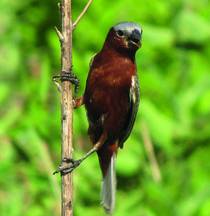Capuchino's Habitat to Be Protected in Uruguay
Image: Capuchino Boina Gris (Sporophila cinnamomea), by Joaquín Aldabe - Aves Uruguay
UPM Forestal Oriental has launched a project in Uruguay to further the conservation of habitats suitable for grassland birds belonging to the genus Sporophila. The project is part of UPM’s Global Biodiversity Programme.
A subset of the seedeater genus Sporophila, or Capuchinos, as they are amusingly known in Spanish, these birds include a number of species threatened on a global level. Of nine species of Capuchinos that nest in Uruguay each spring, four are endangered.
Because of changes arising from cattle grazing, habitats with tall grasslands suitable for the birds have declined. More than 30% of UPM Forestal Oriental’s landholdings remain in untouched condition, and of these some are covered by natural grasslands. Managed properly to assure flowering of tall grasses during the spring, patches of open natural grasslands become suitable for Capuchinos and other grassland birds.
Stakeholder engagement
UPM Forestal Oriental is working together with Aves Uruguay, a non-governmental organisation (NGO) for the study and conservation of birds. Different areas were visited by Aves Uruguay and UPM Forestal Oriental´s experts to define the best sites in terms of conservation status and suitability for Capuchinos nesting, and field surveys are being carried out by Aves Uruguay’s team to assess the area in terms of biodiversity. Aves Uruguay will then recommend the best way to manage the grassland in each area, including possibly the total removal of cattle.
Besides this project, UPM Forestal Oriental continues working closely with local farmers. Cattle grazing is continued, but in a controlled way by using fencing. Grazing is controlled also in accordance with the seasons. Cattle are removed from the area at the beginning of spring allowing the growth of those tall grasses that Capuchinos need for nesting and feeding.
Increase in biodiversity objective
The objective of the project is to promote the conservation of a number of endangered grassland birds through the proper management of natural grasslands. With this project, the expectation is to increase not only Capuchinos populations, but also the general biodiversity of the grasslands ecosystem.
Different areas were visited by Aves Uruguay and UPM Forestal Oriental´s experts to define the best sites in terms of conservation status and suitability for Capuchinos nesting, and field surveys are being carried out by Aves Uruguay´s team to assess the area in terms of biodiversity. Aves Uruguay will then recommend the best way to manage the grassland in each area, including possibly the total removal of cattle in some areas.
Further field surveys will be done to monitor changes, not only in Capuchinos populations but also the overall bird biodiversity.
The project begun in August this year will initially be taken forward in a few pilot areas. “If we succeed, we can expand the project to other areas too,” Grela says. The first results can be expected, he says, by the end of this year.
Text: Tuovi Similä
This article is based on an interview with Ivan Grela, UPM Forestal Oriental’s Head of Environment.

